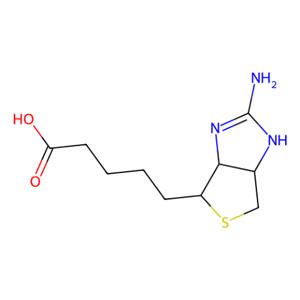| 名称 | 2-Iminobiotin |
| 描述 | 2-Iminobiotin (Guanidinobiotin) is a cyclic guanidino analog of biotin that acts as a reversible inhibitor of inducible nitric oxide synthase (iNOS) and neuronal NOS (nNOS; Ki of 21.8 and 37.5 μM for mouse iNOS and rat nNOS, respectively). |
| 细胞实验 | In vitro hypoxia was induced for 7 h in IMR-32 cell cultures by using our recently described system with minor modifications.?Enzyme stock solutions (100x) of catalase and glucose oxidase ?were diluted in cell culture medium (DMEM/F12, 1% FCS;?final concentration: 120 and 2 U/ml respectively).?A rapid decrease of partial pressure of oxygen (pO2) to levels below 10 mmHg was achieved by adding the enzymes to glucose containing culture medium.?Also a decline in glucose (<1 g/l) and pH (<7.0) was observed, resembling the clinical characteristics of hypoxic-ischemic injury in vivo.?Hypoxic conditions were confirmed with a tissue oxygen pressure monitor .?After the hypoxic insult, cells were washed twice with PBS and cultures were placed into an incubator at 33.5°C (hypothermia) employing culture medium with (i) solvent (citrate buffer 1%) or (ii) 2-IB at 10, 30, 50, 100, and 300 ng/ml.?To determine the optimal "reperfusion" time, a time-interval curve investigating cell damage (LDH release) was performed.?Analyses of LDH release, ROS generation, hydrogen peroxide release, metabolic activity, cell signaling, apoptosis-related protein expression/activity and expression analysis of 35 human apoptosis-related proteins were performed at different time points post-hypoxia[1] |
| 体外活性 | All cultures were subjected to 25 h of hypothermia (33.5°C), and incubated with vehicle or 2-iminobiotin (2-IB) (10, 30, 50, 100, and 300 ng/ml).?Cell morphology was evaluated by brightfield microscopy.?Cell damage was analyzed by LDH assays.?Production of reactive oxygen species (ROS) was measured using fluorometric assays.?Western blotting for PARP, Caspase-3, and the phosphorylated forms of akt and erk1/2 was conducted.?To evaluate early apoptotic events and signaling, cell protein was isolated 4 h post-hypoxia and human apoptosis proteome profiler arrays were performed.?Twenty-five hour after the hypoxic insult, clear morphological signs of cell damage were visible and significant LDH release as well as ROS production were observed even under hypothermic conditions.?Post-hypoxic application of 2-IB (10 and 30 ng/ml) reduced the hypoxia-induced LDH release but not ROS production.?Phosphorylation of erk1/2 was significantly increased after hypoxia, while phosphorylation of akt, protein expression of Caspase-3 and cleavage of PARP were only slightly increased.?Addition of 2-IB did not affect any of the investigated proteins.?Apoptosis proteome profiler arrays performed with cellular protein obtained 4 h after hypoxia revealed that post-hypoxic application of 2-IB resulted in a ≥ 25% down regulation of 10/35 apoptosis-related proteins: Bad, Bax, Bcl-2, cleaved Caspase-3, TRAILR1, TRAILR2, PON2, p21, p27, and phospho Rad17[1]. |
| 存储条件 | Powder: -20°C for 3 years | In solvent: -80°C for 1 year | Shipping with blue ice/Shipping at ambient temperature. |
| 溶解度 | DMSO : 12.5 mg/mL (51.37 mM), Sonication is recommended.
|
| 关键字 | NOSynthase | NOS | NO Synthase | 2-Iminobiotin | 2Iminobiotin | 2 Iminobiotin |
| 相关产品 | Aminopicoline | Diallyl disulfide | Mifepristone | Methylene Blue trihydrate | Chondroitin sulfate | Ethyl cinnamate | Gluconate Calcium | L-Arginine | 2-Isopropyl-1H-imidazole | L-NAME hydrochloride | Magnesium sulfate | 3-AMINO-1,2,4-TRIAZINE |




